GREEK MYTHICAL LANDS: THE ODYSSEY
THE LOTUS EATERS
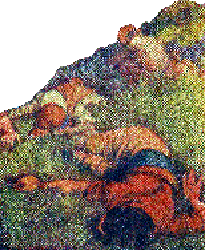
After leaving the Cicones of Thrace, Odysseus' armada encounters storms which blow them well off course. They eventually make landfall in the land of the Lotus Eaters, a tribe in whose land grows a plant with narcotic effects, which is used by the Lotus Eaters as a nepenthe. Several of Odysseus' followes succumb to the effects of the drug and have to be dragged back to the ships a hasty exit is made.
The Lotus Eaters were believed to have inhabited the island of Djerba, in the bay of Syrtis Magna in Libya, where both Hecataeus and Herodotus [4.177] placed a people by the name (Lotophagoi). This tallies well enough with Homer, who has Odysseus blasted off course by the north wind twice (for a total of eleven days) before landing in the domain of the Lotus Eaters [9.82-84]. However, as Robin Hard states, "their land is located in a purely mythical realm in Homer's account," with Robin Lane Fox concurring, indicating that "they belong in 'neverland'."
THE LAND OF THE CYCLOPES
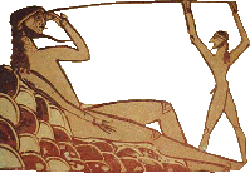
From there, the crew sail to the idyllic home of the Cyclopes (which is probably the "broad Hypereia" mentioned as the Phaeacians' former abode at 6.4-8), where they have a terrifying encounter with Polyphemus, losing several men, before Odysseus' cunning engineers an escape.
Initially, Odysseus & his crew land on an island guarding the entrance to the harbour on the main island, the description of which presents an image of an earthly paradise, abounding in edible vegetation, calling to mind Plato's myth of the age of Cronus in the Statesman [271d], with the primordial anarchism of Cronus' subjects [271e] similar to the lack of centralisation prevalent among the Cyclopes [9.112-115], who live by transhumance and have no specific law codes [9.105-111]. Significantly, a stream runs from flows from a cave, bringing to mind Ogygia and the sources of Oceanus. Atlantis, though dissimilar from the Cyclops' island in many respects, is described in similar terms, as "highly fertile" [Crit. 113c]. Atlantis' fecundity is treated in Crit. 114d-115b. This islet, with its population of goats, also brings to mind the etymology of the names Eumelus and Gadeirus, given to the second twin son of Poseidon [114b]. It is also worth noting that Polyphemus, like the lords of Atlantis, was a son of Poseidon - indeed, Odysseus' injuring of the Cyclops led to the invocation and subsequent wrath of the god on behalf of his son, which would dog Odysseus' endeavours for a decade afterwards. Polyphemus and his fellow Cyclopes, with their one central eye, may represent the fearsome setting aspect of the sun, argues Douglas Frame. Frame regards the episode as complementary to that on Thrinacia covered below, which, like the encounter with Polyphemus, results in a catastrophic loss of personnel.
AEOLUS' FLOATING ISLAND
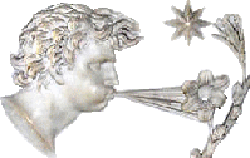
Odysseus makes two visits to the island of Aeolus, god of the winds, where he is initially given a bag of winds, with the aid of which his ships manage to hove into sight of the crew's homeland of Ithaca. However, whilst Odysseus sleeps, the curiosity of his followers gets the better of them and, opening the bag, they are driven back, where they are refused any further help as a result of their stupidity.
The description of the "wall of unbroken bronze," a Homeric attribute reflecting popular beliefs about the dwellings of supernatural entities, is redolent of the wall of Tartarus in the Theogony and Atlantis' concentric walls, each covered in a different metal: "they covered with brass, as though with plaster, all the circumference of the wall which surrounded the outermost circle; and that of the inner one they coated with tin; and that which encompassed the acropolis itself with orichalcum which sparkled like fire" [Crit. 116b-c].
Additionally, Aeolus lives with his six sons and six daughters [10.5-7], who can perhaps be imagined as a vague precursor of Plato's description of Poseidon and his ten sons in Atlantis. Aeolus, as the son of Hippotas, also resembles the figure by the name in the Melanippe genealogy, which the late Slobodan Dušanić argues served as the model for Plato's Atlanteans. In a footnote, Dušanić reminds the reader that "Melanippe's lineage contains an Hippotes and an Hippe."
TELEPYLUS: EVERBRIGHT FASTNESS OF THE LAESTRYGONES
The ships next come into port in the land of the terrifying, gigantic Laestrygones or Laestrygonians, a people with a monarchical government. Entreaties for hospitality are rebuffed in a cruel manner, with the mountain-high denizens hurling rocks at Odysseus' ships & spearing his men. Only Odysseus' ship survives to sail on.
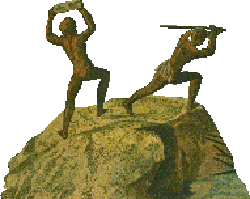
The Laestrygonians are, in common with the Cyclopes, depicted as savage creatures who regard Odysseus and his crew as potential sources of protein and little else. Dimitri Nakassis, from the description of their land as perennially sunlit, places them in the easternmost reaches of Homeric geography and contrasts the description of their realm with that of the Cimmerians. Heinz-Günther Nesselrath places the Cimmerians at "the northernmost point of its [i.e. Oceanus'] circle," which would logically put the Laestrygonians in the south. Their city, Telepylus, means "far away gate" and reflects the gate through which the sun was believed to set out on its daily journey, as well as the corresponding gate to the underworld. Frame notes the similarity in the description of the herdsmen greeting each other and Hesiod's description of Night and Day encountering one another at the gates of Tartarus [Theogony 748-750c], which further serves to locate Telepylus' origins in the eschatology of the Greek underworld. The Laestrygonians also share the distinction of gigantic stature and hostility to humans with the Cyclopes and, as Frame notes, Odysseus leaves his own ship at a safe distance before both adventures. They fit the pattern of savage or supernatural elements present on the edges of the earth and suggest the potentially terrifying effects of an invasion from such a zone, as is the case with Atlantis.
AEAEA: CIRCE'S CONSONANT-FREE ISLE

A short sail from the Laestrygonians, Odysseus lands on the island of Aeaea, the home of the powerful sorceress Circe. A small group of men is dispatched to reconnoitre the island, but they are transformed into pigs by the sorceress. Odysseus is spared a similar fate through the intervention of his ancestor Hermes [10.275-279], who gives him a herb, moly, which makes him invulnerable to Circe's magic. Defied in this way, Circe agrees to undo her work and provides considerable hospitality in her "house of polished stone" [10.210-211] with "shining doors" [10.230]. It is she who reveals the next stages of the journey, including a visit to the underworld to consult the shade of Teiresias [10.524, 537], after which they return and are given further aid by the enchantress.
Though Homer explicitly places Circe's home in the east "where Eos the Dawn has her House and Dancing Floor: [...] where the sun rises" [12.3-4d], later tradition, beginning with the pseudo-Hesiodic Catalogue of Women, which places her on "the island over against Tyrrhenia" [Fr. 46], suggests that she was in the west, with Monte Circeo, a peninsula in southern Latium, representing something of a consensus, to which she was transported on the chariot of her father Helios by her brother Æëtes. The Catalogue specified the location as "Hesperian." Additionally, as Frame notes, Odysseus is unable to ascertain their location during the first visit to Aeaea due to an inability to discern where the sun rises and sets. Though Nakassis suggests that this is due to the crew's being in the furthest east, it is equally likely that Aeaea may have shared some properties with Aeolus' floating island. Vestiges of her presence in the east survived in the form of a "Circaean plain" in Æëtes kingdom of Aea (later identified with Colchis), which appears in the Argonautica of Apollonius of Rhodes [2.402; 3.200]: -
The Argonautica, which reiterates Circe's western location and repeats the myth of her transportation [3.309-313], elaborates on the menagerie present on Aeaea: alongside the cowed beasts of the Odyssey, Circe now has a retinue of hemilovecraftian aberrations, generated from "primeval slime" on the island [4.671-674].
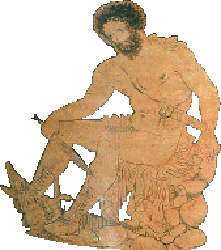
THE LAND OF DARKNESS: EREBUS AND THE CIMMERIANS
The realm of the Cimmerians is close to the entrance to the land of the dead, termed Erebus [10.528], meaning "darkness" and this is stated to be in the extreme west of the Homeric world [ibid., cf. 12.80-81]. "there was a tendency to place the abode of the dead in the West," writes H.J. Rose, who continues by stating that "the two ideas [i.e. an underground & extreme western land of the dead] were reconciled at an early date (we find the process complete in the Odyssey) by supposing some locality in the farthest known West to be the entrance, or at least the normal entrance, to" Hades' realm. In addition, Robin Lane Fox proffers a tantalising suggestion for the origin of Homer's description of "a rock where two roaring rivers join the Acheron, Cocytus, which is a tributary of the Styx, and Pyriphlegethon" [10.513-514] from the dimly-known west: -
With regards the relationship between the Homeric Cimmerians and the historical group of nomads who bore this name, it may be mear coincidence, or else it could betray the influence of an early Argonautica which knew of Cimmerians dwelling in the area east of Colchis, as was the case during their entrance into historical record in around 714 BC.
THE WAY TO EREBUS
Circe describes to Odysseus the perilous route he must take to reach the underworld, and the precise nature of the rituals he must perform in order to make his enquiries of Teiresias: -
ANTHEMOESSA: HOME OF THE SIRENS
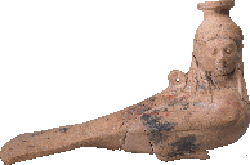
Circe describes Odysseus' forthcoming encounter with the Sirens and the precautions he must undertake to ensure his safety should he (as he inevitably does) wish to hear their song. The Sirens appear to have preternatural knowledge of who it is they are addressing . The Argonauts, who have also passed this way, are fortunate to have among their number the peerless musician Orpheus, whose music drowns out the Sirens' song. The name Anthemoessa is derived from Hesiod and means "flowery meadow."
SCYLLA AND CHARYBDIS
As soon as the Sirens had been passed, Odysseus comes upon "spray, and huge breakers, and heard their thunder" [12.202]. He has been given a choice of two courses by which to reach Thrinacia, the island of Helios, either via the twin dangers of the sea monster Scylla and the whirlpool Charybdis or the Planctae or Wandering Rocks, which had been encountered by Jason during his flight from Aea.
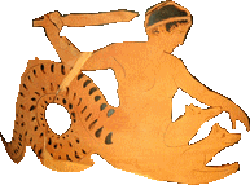
Choosing the former, a precarious passage is made between Scylla and Charybis with the loss of several hands. Both the Planctae and the strait between Scylla and Charybdis seem to carry vestiges of an axis mundi: the Planctae are described as "sheer cliffs" [12.59] while the strait is located between "two cliffs, one whose sharp peak towers to the wide heavens. A dark cloud caps it that never vanishes to leave clear skies, even in summer or at harvest" [12.73-75]. In the case of the latter, the description is highly reminiscent of Herodotus' account of Mount Atlas [4.184]: "so lofty, moreover, that the top (it is said) cannot be seen, the clouds never quitting it either summer or winter."
Homer makes Scylla the daughter of Crataiis [12.124], probably a form of Hecate: The Great Eoiae [Fr. 13], also ascribed to Hesiod, makes her the daughter of Helios and this dread goddess. A possible chthonic resonance for Scylla also appears the description of her cave, which is described as "facing West towards Erebus" [12.80-81]. Scylla's normal diet was "dolphins and seals or one of the greater creatures that Amphitrite breeds in countless numbers in the moaning depths" [12.96-97], though she was not averse to supplementing this with hapless passing sailors, as several of Odysseus' crewmates found to their cost.
With regards to Charybdis, the description of this monster, whose origins certainly lay in sailors' tales of whirlpools and who was later rationalised as such a phenomenon, alternately sucking in and spewing out the waters of the sea suggest some measure of commonality with Ogygia: whereas Ogygia is described as being located at the ὀμφαλός [...] θάλασσα [1.50], Charybdis has the functions expected of the "navel of the sea." Paulus Diaconus, a.k.a. Paulus Warnefridi, makes mention of northern whirlpools and draws comparisons with Charybdis: off the shore wherein seven sleepers dwell in a cave (a story transported hence from the south, where early Christian sources place seven sleepers in a cave at Ephesus) near the Scritobini ("Skridfinns," almost certainly a Sami population) "on the west, where the ocean extends without bounds, is that very deep abyss of the waters which we commonly call the ocean's navel. It is said twice a day to suck the waves into itself, and to spew them out again; as is proved to happen along all these coasts, where the waves rush in and go back again with fearful rapidity. Such a gulf or whirlpool is called by the poet Virgil Caribdis" [1.6]. Viktor Rydberg, in his idiosyncratic exploration of Germanic mythology, associates the navel of the ocean with the Grotte-mill and Hvergelmir.
As the medieval period drew on, the great whirlpool which drew in the waters of the ocean came to be located at the North Pole. A 13th century English friar purported to provide a description of the region, which he had visited as an emissary of Edward III of England, wrote a work called the Inventio Fortunata, which was summarised by Jacobus Cnoyen, a Brabantian traveller. Cnoyen's summary formed the basis for the speculative depictions of the northern polar region which appeared on maps of the Early Modern period. On them, the Pole itself is marked by a great black stone with significant magnetic properties, the Rupes Nigra, beneath which the whirlpool which drew in the waters of the ocean was located. Four rivers converged on the spot, each flowing at an angle of 90° from the next, creating four large islands and forming a sea, the Segenum Sea, around the Rupes Nigra. The islands were named "Aronphei, Insula Deserta, Hyperoborei and Europa, and another Insula Deserta with Pilapelanti Peninsula" on Johannes Ruysch's 1508 map Universalior Cogniti Orbis Tabula Ex Recentibus Confecta Obsevationibus. Hyperoborei is clearly intended as the home of the classical Hyperboreans, while Aronphei, to the north of the Americas, also has a possible precedent. According to Alan G. Macpherson: -
The "Arumfeie" are presumably identical to Gerardus Mercator's "Pygmei" who inhabit the polar island to the north of Greenland in his 1595 map Septentrionalium Terrarum Descriptio, of whom he states "in Gronlandia Screlingers vocant." Both would thus originate in Norse accounts of the Skrælingjar, given to various Inuit and First Nations peoples (as well as legendary creatures) encountered by the Norsemen during their exploration and settlement of Greenland and the eastern seaboard of Canada.
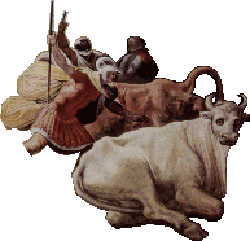
THRINACIA AND THE CATTLE OF THE SUN
Another disastrous failure to control his men invokes the anger of the sun god Helios, who implores Zeus to thrash the transgressors. All but Odysseus pay with their lives. Helios, for his part, is content to withdraw his threat to shine instead on the underworld dwellers. His flocks of kine and sheep number altogether 350 of each, which is often compared to the number of days in the year, which would be appropriate for the god of the sun.
Nakassis' "western" counterpart of "oriental" Thrinacia is found on Erytheia, home to the pastures of Hades, lord of the dead. Heracles, in the course of his adventures, had cause to visit there to drive back the cattle of Geryon (perhaps identical with Hades' herd) on behalf of his tormentor Eurystheus. As a side note, Hades' cowherd Menoites may be identical with Menoiteus, a brother of Atlas and Prometheus damned by Zeus for his hybris.
OGYGIA: CALYPSO'S HOME IN THE NAVEL OF THE SEA
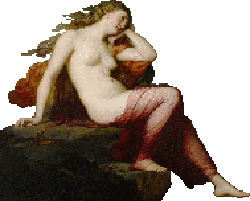
Seven years out of the ten spent by Odysseus between his leaving Troy and landing in Ithaca were spent on Ogygia, the far western homeland of the nymph Calypso, a daughter of Atlas. According to Dimitri Nakassis, as noted elsewhere, Calypso possibly originated as a geminant of Circe in the confusion engendered by the transition from a unipolar to a bipolar view of the solar journey through the heavens. According to Nakassis, "Kalypso's geographical location corresponds to her genealogy as the daughter of Atlas (Od. 1.52), since Atlas supports the earth from Tartaros" and, reviewing previous scholarship, notes that "[Douglas] Frame has noted the close correspondence between the Homeric description of Kalypso and the Hesiodic description of Styx, where 'Ogygian' is used of the Stygian water (Th. 805-6) as an adjective meaning 'primeval.'" Calypso's intimate connection with Atlas' role in supporting the cosmos is found in Homer's description of Ogygia, where at "the fringes of the island [...] stands of alder, poplar, and fir rose to the sky" [5.238-239]. Atlas is also found in the west in the Theogony: "Atlas through hard constraint upholds the wide heaven with unwearying head and arms, standing at the borders of the earth before the clear-voiced Hesperides" [275], as is Tartarus [731], as well as beneath it [721-722; 746-747]. Similarly, Nakassis notes that, despite its remoteness, Ogygia is described as being in the "navel of the sea" [ὀμφαλός [...] θάλασσα, 1.50].
With regards to Ogygia's being the "navel of the sea," it is worth noting that the term ὀμφαλός can signify either a central point or a "plug or valve closing outlet of bath." These definitions coincide in the medieval vision of the Rupes Nigra at the North Pole, which sucks in, or alternately sucks in and spits out, the waters of the sea and tally with the Homeric description of Charybdis: "[...] divine Charybdis swallows the black waters. Three times a day, she spews them out, and three times darkly sucks them back again" [12.104-106]. Compare the four fountains around Calypso's grotto: "four neighbouring springs, channelled this way and that, flowed with crystal water" [5.70-71], which have a configuration similar to the four rivers leading to (admittedly as opposed to radiating outwards as is the case on the Ogygian isle) the Rupes Nigra on early modern maps. As such, it may be possible to trace the origins of medieval beliefs about the nature of the North Pole back to Homer. Projecting these notions back further, it may be possible to see Ogygia's (and perhaps Charybdis') function as omphalos of the sea back to Mesopotamian cosmological notions of the apsû or abzû, a sea of fresh water which lay beneath the earth. In the Enûma Eliš, the surviving examplar of which was found in the Library of Assurbanipal at Nineveh, which was set up in the 7th century, Apzû is the primordial personification of fresh water: -
It may be that the water of Calypso's fountains, described as flowing "with crystal water," represent the production of fresh water, with Charybdis recycling brine. The notion of the four streams also appears in the Biblical Book of Genesis [2.9-14]. Though not explicitly called by the name, the four fountains may also represent the pegae or springs from which the river Oceanus has its source, as mentioned in the Theogony [280-282]: -
Furthermore, Hesiod records Pegasus' being conceived "in a soft meadow amid spring flowers" [279], a description markedly similar to that given by Homer for the course of the streams, lending further weight to the suggestion.
CALYPSO AND STYX
With regards to Styx, who is, as noted by Frame and Nakassis, given the epithet Ogygian by Hesiod [Theogony 805-806], "she lives in her famous palace which is overroofed with towering rocks, and the whole circuit is undergirded with silver columns, and pushes heaven" [777-779]. The river itself "is one horn of the Okeanos stream, and travels off that holy river a great course through night's blackness under the wide-wayed earth and this water is a tenth part of all, for in nine loops of silver-swirling waters, around the earth and the sea's wide ridges he tumbles into salt water, but this stream, greatly vexing the gods, runs off the precipice" [789-792] (cf κατειβόμενον Στυγὸς ὕδωρ, Odyssey 5.185). The "towering rocks" which top Styx's palace render it easy to imagine said palace as being similar to Calypso's "vast cave," whilst the "silver columns" which "push [...] heaven" are reminiscent of "the great columns that separate earth and sky" which Calypso's father Atlas supports in the Odyssey [1.53-54]. The issuing place of Ocean also appears in a lament of Penelope [20.61-78], in which she implores Artemis to "let the storm wind snatch me up, carry me over the darkened ways, and abandon me at the mouth of Ocean's backflow [ἐν προχοῇς δὲ βάλοι ἀψορρόου Ὠκεανοῖο]" [20.63-65].
Another potential connection between Calypso and Styx is her swearing a grave oath by the river not to harm Odysseus [5.184-187]. Despite the gravity of such an undertaking, Calypso, though well aware that Odysseus will reach home after many further trials [5.205-210], gives the hero a parting gift of a set of clothes [5.262-264] which almost prove to be his undoing after Poseidon attempts to drown him [5.321]: eventually, he is forced to heed Leucothea's advice [5.343] and jettison them in order to save himself from drowning [5.372]. Thus, it is evident that Calypso likely attempted to bring about the demise of the lover who spurned her in spite of the severity of the consequences of breaking an oath which is said to bind even the Olympians [Theogony 400-401, 782-787]. That no specific punishment for this transgression is mentioned in the case of Calypso, in contrast to the Phaeacians [13.159-187], may suggest that Calypso is, at least in part, a cipher for Styx. An identification of the "mouth of Ocean's backflow" with Ogygia may further connect Calypso to the underworld: Pandareus' daughters, who are cited by Penelope as an example, were transported hither to serve the Erinyes [20.77-78].
OGYGIA AND OGYGES
The name of Ogygia also coincides with that of the Boeotian and Attic flood hero Ogyges or Ogygus, whose name has been compared to that of Oceanus, and his legend associated with the defeated primordial god Ophion, by Joseph Eddy Fontenrose and Tomislav Bilić.
There are other resonances with regards to Plato's villains: writing in the century after Plato, Lycophron calls Calypso by the epithet "Atlantis," in the tradition sense of a daughter of Atlas [Alexandria 744-745]. It is not without the bounds of possibility that Plato's association of the name of his island with a word bearing this meaning is partially influenced by Calypso and other figures described as daughters of Atlas who inhabit the far west.
OGYGIA IN THE OCEAN
Interestingly, despite the chthonian resonances associated with Ogygia, Nakassis also adds that "[b]oth [Circe and Calypso] live on islands with pronounced affinities to the 'Isles of the Blessed,'" and both are associated by the scholar with the passage of the sun: "as one who 'covers' (or 'conceals') and lives in a cave, [Calypso] is associated with the setting sun, darkness, and death," echoing the similar treatments of the Laestrygonians and Cimmerians. Additionally, "despite the close similarities between Kalypso and Kirke, a number of authors have noted that Kalypso is the more sinister of the two." Circe's later transportation to a western locale, however, led to some measure of confusion between the two: in a number of sources [Propertius 3.12.21; Pomponius Mela 2.120; Fabulae 125], Calypso is specifically stated to inhabit Aeaea rather than Ogygia.
Though later associated with the island of Gozo in the Maltese archipelago, Ogygia's place in the far western reaches of the Homeric geographical schema can be gleaned from the time it takes to travel between Ogygia and what is presumably the nearest land to the east: -
Returning once more to Nakassis, we read: "Skherie [the land of the Phaeacians] is situated on the remote western fringes of the Greek world, hence Ogygie must be located even further to the west." It is also worth noting that Strabo, who placed most of Odysseus' ports of call firmly on the map, regarded Ogygia and Scheria as as "imagined in fantasy" [1.2.18] and being located in Oceanus [7.3.6]. Plutarch also had Ogygia in a remote location "a run of five days off from Britain as you sail westward," inspiring the Irish historian Ruaidhrí Ó Flaithbheartaigh to name his magnum opus after Calypso's island. Whilst pondering why, if this was the case, Odysseus managed to avoid Britain on his way to Scheria, or why Calypso was apparently ignorant of its existence, it is worth noting that Plutarch is here relating a philosophical myth in the tradition of Plato. In it, the Carthaginian Sulla relates what he has heard from a mysterious traveller of Greek stock who has come from far afield. According to Sulla's informant, Ogygia has: -
"On the coast of the mainland," Sulla continues, "Greeks dwell about a gulf which is not smaller than the Maeotis and the mouth of the Caspian sea" and "call themselves continentals and the inhabitants of this land islanders because the sea flows around it on all sides." The Greek settlers reached the opposite continent in two waves: first with Cronus and thereafter thanks to Heracles "and were left behind by him and that these latter so to speak rekindled again to a strong, high flame the Hellenic spark there which was already being quenched and overcome by the tongue, the laws, and the manners of the barbarians." The tale continues by stating that expeditions are dispatched by these Greeks at thirty year intervals, and "those who survive the voyage first put in at the outlying islands, which are [also] inhabited by Greeks, and see the sun pass out of sight for less than an hour over a period of thirty days, - and this is night, though it has a darkness that is slight and twilight glimmering from the west." On one of the islands, as noted, Cronus is confined and "sleeps confined in a deep cave of rock that shines like gold - the sleep that Zeus has contrived like a bond for him."
SCHERIA: LAND OF THE PHAEACIANS

The last stage in Odysseus' arduous journey takes him to the land of the Phaeacians, Scheria. The inhabitants of the place are again somewhat more than human: "[e]ven if one of us walking the road alone were to meet [the gods], they used no disguise, since we are next of kin to them, like the Cyclopes and the wild tribe of Giants" [7.204-206]. Their genealogy reflects their kinship with these less civilised liminal groups: "Arete is her name, of the same lineage as the king, Alcinous. Nausithous was founder, born of Earth-Shaker Poseidon and Periboea, loveliest of women, youngest daughter of valiant Eurymedon once king of the insolent Giants." [7.54-59]. They enjoy a high culture and are masterful sailors, boasting supernatural powers over their vessels: "Phaeacian ships have no helmsman or steering oar, for the ships themselves know our thoughts and wishes, and the cities of men, every fertile country, and hidden by mist and cloud they speed over the sea's wide gulf, and never fear damage or shipwreck" [8.557-563]. Their city has a high wall [6.9-10] and the palace of King Alcinous is a wonder to behold, featuring automata created by Hephaestus: -
Alcinous also has a garden whose production of two crops a year: -
The legendary wealth of hyperstelean Tartessus is one potential source for Homeric Scheria, though Douglas Frame, as part of his deep investigations into the roots of the Homeric mythology surrounding Nestor, proposes that the rulers of the Phaeacians are ciphers for the family of that hero, and that the Homeric description of the Phaeacians was intended as a means to flatter the wealthy rulers of the Ionian Dodecapolis (Miletus, which traced the descent of its ruling class from Nestor's line, in particular), developing a hypothesis that the Homeric epics were formalised, at least in part, for use at the Panionion, with propagandistic elements aimed at normalising the Milesian-derived myth of the descent of the founders of the cities of the Dodecapolis from the sons of the Neleid Codrus.
Though Scheria was later identified with the island of Corfu, whose local football team bear the nickname Φαίακες ("Faiakes"), the Phaeacians themselves inhabit a distant realm: Scheria is specifically said to be "far from men" [6.8] and the Phaeacians "live far-off, over the turbulent sea, the remotest of races, and deal with no other peoples" [6.204-205]. They did, however, transport Rhadamanthus to Euboea on one occasion [7.321-324]. The most likely scenario is that the Phaeacians are intended as a people of the far west, following Strabo [1.2.18, 7.3.6], though Timothy Bridgman places them instead in the far east. Their name may derive from φαιὀς meaning "grey" or "blackish," related to φαικὀς meaning "bright," with a theory developed by Friedrich Welcker, which has not met with a universally positive reaction, suggesting that they have their origins in the ferrymen of the dead. However, their idyllic island and carefree lifestyle do not sit easy with such a role and mark them as a similarly fantastical people of the margins of the earth as the Fortunate Isles, realm of the Hyperboreans and, during the earlier phase of its history, Atlantis. Indeed, Erwin Cook's review and update of Welcker's theory, in which the Phaeacians are made ferrymen working specifically to and from the Elysian Fiends, is far more satisfying and works well given the mention of Rhadamanthus, who is elsewhere given rulership of the happy realm of the blessed dead.
Their habit of providing free and efficient transport incurred the wrath of Poseidon, who has previously threatened to punish them: Alcinous relates that "[t]hough I heard a story once from my father Nausithous, who used to say that Poseidon was angry with us because we conveyed all men, in safety. He claimed that some day, when a well-built Phaeacian ship was crossing the misty sea, returning from such a journey, Poseidon would strike her, and then ring our city with a mountain chain" [8.564-569]. After they finally ferry Odysseus back to Ithaca, the incensed sea god petrifies the transport ship as it reaches the Phaeacians' harbour [13.159-167]. They are last heard of desperately trying to ward off his threat to ring their land with mountains [13.184-187].
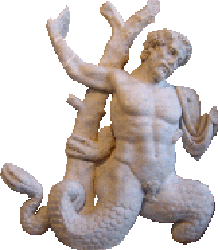
APERAEA, EURYMEDUSA AND EURYMEDON
The only other place mentioned is the enigmatic Aperaea or Apeire, the homeland of Nausicaa's nursemaid Eurymedusa, from where she was abducted in "curved ships" and awarded to Alcinous as a prize [7.8-11]. The name of this place signifies a "limitless land" which could easily be interpreted as a forerunner of Plato's "opposite continent" [Tim. 24e-25a]. Whether it is related to Hypereia ("high land"), the Phaeacians' former home, is unclear but would appear unlikely, given that, as the Cyclopes drove them from Hypereia, that country was likely the otherwise-unnamed land in which Polyphemus dwelt. Furthermore, the name of the servant woman, Eurymedusa, is the female form of that of Eurymedon, the villanous leader of the giants who served as the Phaeacians' maternal ancestor. Both names are related to εὐρυκρείων and mean "wide-ruling."
MENELAUS' OWN ODYSSEY
Menelaus himself experienced an arduous journey on his way back from Troy. His contendings with the "Old Man of the Sea" Proteus off the Egyptian coast are well-known. Indeed, later writers imagined that the "real" Helen, Menelaus' supposedly-errant wife, was whisked off to Egypt during the course of the conflict at Troy, with Paris having to content himself with a phantasm.
Many of the peoples visited by Menelaus are real enough: Cyprus, Phoenicia and the Sidonians and, of course, Egypt are self-explanatory. The Ethiopians are, however, often located at either end of the earth: Poseidon, among other gods, is wont to visit them. The Erembians are unidentified, with later writers suggesting the Arabian cave-dwellers. The Libyans Menelaus meets appear to dwell in a shepherd's paradise, with Lane-Fox suggesting that they are to be found in the regions around Carthage and Lake Tritonis in modern-day Tunisia, rather than the Cyrene region familiar to later Greeks.
SYRIE AND ORTYGIA: THE TALE OF EUMAEUS
Not to be confused with Syria in the Levant, Eumaeus' homeland of Syrie is located at the turning point of the sun, perhaps in the extreme west or north-west. Ortygia, which appears in the myth of Orion, is commonly identified by later writers with the small island in the harbour at Syracuse.
